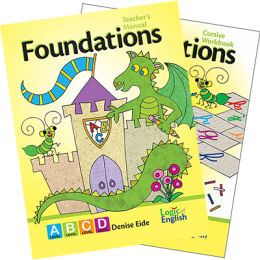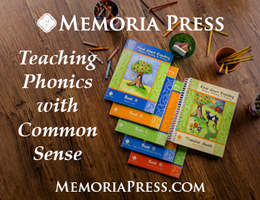Foundations courses A through D comprise the beginning program within the Logic of English’s language arts program. While it can be used with children ages four through seven, Foundations is probably ideal to begin at kindergarten level for most children. The publisher suggests various sequences on their website, but the most common sequence will be to complete two courses per year. That means you might complete levels A and B in kindergarten and levels C and D in first grade. From there, you can move into Logic of English Essentials.
Foundations is a little more advanced than some other programs, even if you begin with course A in kindergarten. Correlation to the Common Core Standards at the front of each teacher’s manual shows that A covers some first-grade level standards as well as those for kindergarten while B covers even a few standards for second grade. Consequently, you should proceed at a pace that is comfortable for each child, using the multi-sensory activities and pausing at the review lessons to make sure students have mastered the necessary concepts before moving ahead.
Some might recognize the underlying Orton-Gillingham philosophy for teaching language arts in Foundations. That approach recommends teaching reading, writing, handwriting, and spelling together for mutual reinforcement. Students learn all of the sounds for each phonogram at the same time. That means that when the letter “a” is introduced, students learn the three primary sounds the vowel is likely to make rather than just the short-a sound as is taught in most programs.
In addition, Foundations helps children learn the way sounds are formed by the mouth, tongue, and voice box from the very beginning so that children develop awareness by listening for the sounds, feeling how they are pronouncing them, and watching the teacher pronounce them.
Logic of English recommends systematic handwriting instruction. Directions for how to teach both cursive and printing (called manuscript in Foundations) are included in the teacher's guides so that you may choose which one you prefer. The instructions for both styles are clearly presented with side-by-side boxes—green boxes for cursive instruction and blue boxes for printing. You need to be sure to choose either the manuscript or cursive student workbook for each level.
Foundations is a thoroughly multi-sensory program, although it is left to the teacher to decide whether children are ready for handwriting worksheets in course A. The course’s author, Denise Eide points out that some children should practice forming letters with large motor movements while they are still developing the requisite fine motor skills. Both large and small motor activities are included in the program with many interactive activities and games built into the lessons. Multi-sensory activities are presented both as basic learning strategies and as “Multi-Sensory Fun” sidebars that are sometimes optional.
Lessons are written for either classroom instruction or teaching a single student. Some lessons include two versions of a game—one for a classroom and one for a single student—while other games work in both settings. Some group activities are important for helping students grasp the concepts, and you can often use them with just a parent and a child.
Detailed lesson plans are scripted with instructions for each step of the lesson which makes it easy for the inexperienced teacher or parent. Some lesson preparation is required. Each lesson lists the objectives and materials needed at the beginning. In addition to the course materials, you will need a few items such as Lego® blocks (or something similar), markers, crayons, chalk, scissors, glue, and crackers. For course A, you will also create a “sensory box” using a shallow pan or box filled with salt or cornmeal; students can practice writing phonograms in the sensory box.
The program also comes with a custom whiteboard with a five-inch tall writing line on one side and rows of 1 1/16 inch lines on the reverse. The teacher generally uses the large line to demonstrate strokes and letter formation. Students practice in various ways. First, they “write” with their arms or fingers in the air, on the ground, in the sensory box, on handwriting cards (that come with the program), and on the whiteboard. Then they write with markers on the whiteboard, in the workbook, or on handwriting practice pages. Gradually they progress to writing with pencils and pens.
After every fifth lesson, there is a review and assessment lesson so that parents and teachers can make sure students have mastered concepts before moving on rather than for grading purposes. Optional practice ideas are included for you to use as needed to address weak areas identified by the assessments.
Student workbooks are printed in full color. Some pages at the back of the level A workbook are used to construct readers. The student workbook is used within the context of the teacher’s lesson presentation and cannot be used for independent study. You will need one student workbook for each level. For levels A and B, you will also pick your choice of cursive or manuscript.
The Foundations program also requires other specialized items from Pedia Learning: Basic Phonogram Flashcards, Phonogram Game Cards, the custom whiteboard described above, Rhythm of Handwriting Tactile Cards (with raised, sandpaper-like strokes, letters, and numbers), and the Rhythm of Handwriting Quick Reference folder. (For the last two items you will choose either manuscript or cursive style.) Foundations recommends that you have two decks of the Phonogram Game Cards. These are published in three versions: manuscript, cursive, and bookface. You should probably purchase a bookface deck plus either of the other decks. The publisher recommends a few other optional items you might consider such as letter tiles and Bob Books readers.
Foundations A
Course A has 40 lessons and 8 review lessons. It teaches all of the single-letter phonograms a through z and their various pronunciations as well as the phonogram qu. This level presents only the lower-case forms. Students develop phonemic awareness in words as they learn to identify initial, middle, and ending sounds in words. Students are introduced to blending with auditory activities from the beginning of the program. The blending activities prepare students for lesson 21 which presents the first three spelling (and reading) words: cat, dad, and sad. Students might write the words or spell them with letter tiles. By the end of course A, students can read many high-frequency consonant-vowel-consonant words and some one-syllable words with consonant blends.
A colorful hardcover book, Doodling Dragons: An ABC Book of Sounds is part of the course materials for course A. The first week or two, you will also be reading aloud your own Dr. Seuss books as part of each day’s lesson since these books help introduce phonograms by “playing” with the sounds of words in a delightful way.
Foundations B
Course B continues with upper-case letters and more complex phonograms with lessons numbered 41 through 80. As with course A, there are eight review lessons. Students learn how to identify vowel sounds by marking them with curved lines, straight lines, and two dots (i.e., breves, macrons, and umlauts). They also draw lines to identify phonograms such as tch. Ten spelling rules are taught in the course. Spelling lists are included in every lesson except the review lessons. Students practice forming the words by writing them or using letter tiles. There are no spelling tests. By the end of course B, students are reading and writing sentences such as, “Did you clean the sink?” The emphasis is on auditory and visual recognition more than on written work at this level. Optional challenge activities include dictation sentences.
Whistling Whales: Beyond the Sounds of ABC is the colorful, hardcover, read-aloud book used with Foundations B. A set of eight small readers is used for reading practice, and you might want to use additional practice readers.
Foundations C
Course C adds 11 more spelling rules, 27 multi-letter phonograms, and the schwa sound. Students learn to read multi-syllable words. As students become more fluent readers they are given paragraphs to read with questions to answer about what they have read. This level has 40 lessons with eight review lessons.
Knitting Knights, the third book in the Doodling Dragons series, is used as a read-aloud with Foundations C. As with Foundations B, a set of eight readers is used for reading practice, but as children become more fluent readers they often need additional reading material.
Foundations D
Course D has 40 lessons and 8 review lessons. While this level includes eight readers, it also incorporates a set of children’s literature that includes books such as Little Bear and Mouse and Mole that you obtain separately.
Students learn six more spelling rules and some advanced phonograms. They are expected to write sentences with minimal help and begin to construct their own sentences. Reading comprehension skills are taught as students learn to sequence events, identify the main idea and the main character, and explain how the story was resolved.
Summary
Foundations makes the Orton-Gillingham methodology easy to use without any training. It provides thorough coverage of language arts for the early grades in an integrated fashion that saves you the trouble of selecting separate handwriting and spelling programs.











